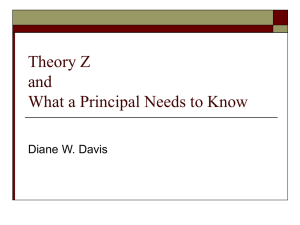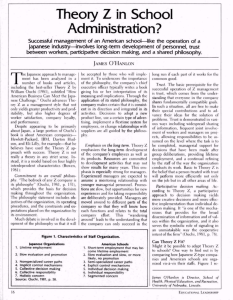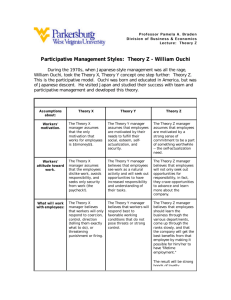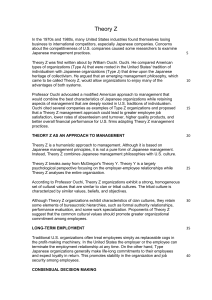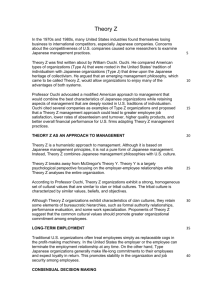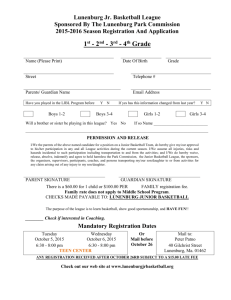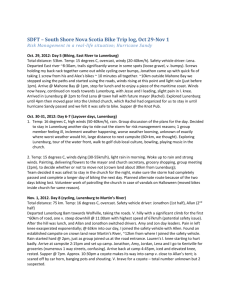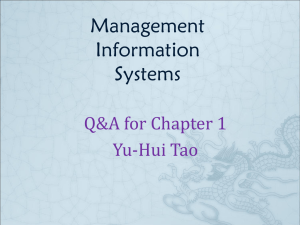Organizational Culture-Performance Relationships: Views of
advertisement
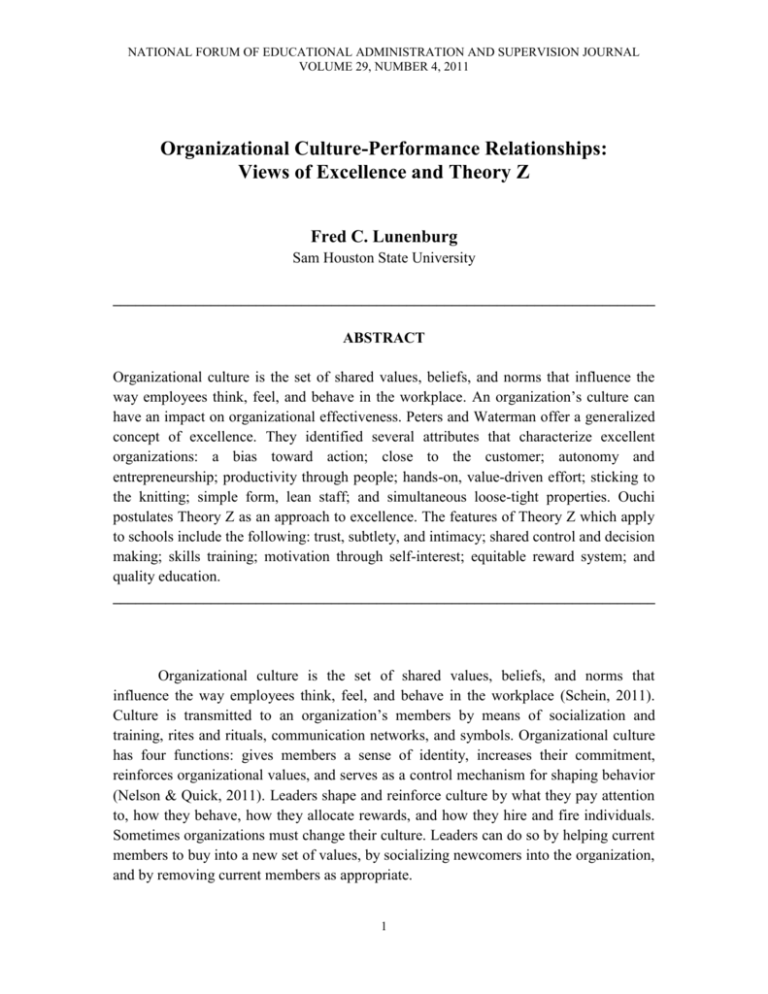
NATIONAL FORUM OF EDUCATIONAL ADMINISTRATION AND SUPERVISION JOURNAL VOLUME 29, NUMBER 4, 2011 Organizational Culture-Performance Relationships: Views of Excellence and Theory Z Fred C. Lunenburg Sam Houston State University ________________________________________________________________________ ABSTRACT Organizational culture is the set of shared values, beliefs, and norms that influence the way employees think, feel, and behave in the workplace. An organization’s culture can have an impact on organizational effectiveness. Peters and Waterman offer a generalized concept of excellence. They identified several attributes that characterize excellent organizations: a bias toward action; close to the customer; autonomy and entrepreneurship; productivity through people; hands-on, value-driven effort; sticking to the knitting; simple form, lean staff; and simultaneous loose-tight properties. Ouchi postulates Theory Z as an approach to excellence. The features of Theory Z which apply to schools include the following: trust, subtlety, and intimacy; shared control and decision making; skills training; motivation through self-interest; equitable reward system; and quality education. ________________________________________________________________________ Organizational culture is the set of shared values, beliefs, and norms that influence the way employees think, feel, and behave in the workplace (Schein, 2011). Culture is transmitted to an organization’s members by means of socialization and training, rites and rituals, communication networks, and symbols. Organizational culture has four functions: gives members a sense of identity, increases their commitment, reinforces organizational values, and serves as a control mechanism for shaping behavior (Nelson & Quick, 2011). Leaders shape and reinforce culture by what they pay attention to, how they behave, how they allocate rewards, and how they hire and fire individuals. Sometimes organizations must change their culture. Leaders can do so by helping current members to buy into a new set of values, by socializing newcomers into the organization, and by removing current members as appropriate. 1 NATIONAL FORUM OF EDUCATIONAL ADMINISTRATION AND SUPERVISION JOURNAL 2____________________________________________________________________________________ Organizational culture has the potential to enhance organizational performance, employee job satisfaction, and the sense of certainty about problem solving (Kotter, 2012). If an organizational culture becomes incongruent with the changing expectations of internal and/or external stakeholders, the organization’s effectiveness can decline as has occurred with some organizations (Ernst, 2001). Organizational culture and performance clearly are related (Kopelman, Brief, & Guzzo, 1990), although the evidence regarding the exact nature of this relationship is mixed. Studies show that the relationship between many cultural attributes and high performance has not been consistent over time (Denison, 1990; Sorenson, 2002). Based on what we know about culture-performance relationships, a contingency approach seems to be a good one for leaders to adopt (Burns & Stalker, 1961; Burt, Gabbay, Holt, & Moran, 1994). Further investigations on this issue are unlikely to discover one “best” organizational culture, either in terms of strength or type (Hellriegel & Slocum, 2011). However, we do know that employees of an organization with a strong culture will follow its values with little questioning. A weaker culture provides only broad guidelines to its members (DuBrin, 2012). We can summarize the effects of organizational culture on employee behavior and performance based on four key ideas (Bulach, Lunenburg, & Potter, 2012; Hellriegel & Slocum, 2011). First, knowing the culture of an organization allows employees to understand both the organization’s history and current methods of operation. This insight provides guidance about expected future behaviors. Second, organizational culture can foster commitment to the organization’s philosophy and values. This commitment generates shared feelings of working toward common goals. That is, organizations can achieve effectiveness only when employees share values. Third, organizational culture, through its norms, serves as a control mechanism to channel behaviors toward desired behaviors and away from undesired behaviors. This can also be accomplished by recruiting, selecting, and retaining employees whose values best fit the values of the organization. Finally, certain types of organizational cultures may be related directly to greater effectiveness and productivity than others. Two models of organizational culture that have the potential to impact organizational effectiveness are Peters and Waterman’s (2006) views of excellence and William Ouchi’s Theory Z (1993). Each one will be discussed in turn, with application to schools. FRED C. LUNENBURG ____________________________________________________________________________________3 Views of Excellence Thomas Peters and Robert Waterman (2006) in their search for excellence in America’s best-run companies found organizational culture to be closely tied to the success of those firms. From their research, they identified the following attributes that characterize excellent companies. Each one of these attributes can be applied to schools. A Bias toward Action The organization continually does, experiments, and tries. An example in a school setting might be implementing strategic planning to guide a school district’s mission and measure its results. Such a plan may lead to a rethinking of the school’s mission and priorities, with everyone in agreement on them. Existing methods, materials, and environments may need to be replaced by new teaching and learning strategies where success for every student is the goal. Individual differences among students are addressed. Ultimately, what may result is a total restructuring of the American system of education as we know it. Close to the Customer The organization looks to the customer for direction in the formation of new products, quality, and service. School districts that remain tuned-in to their clients’ (students’) needs while maintaining a close professional relationship with parents remain “close to the customer.” Different types of family and community involvement were found to distinguish high-achieving schools from low-achieving schools (Epstein, 2010). Autonomy and Entrepreneurship The organization values and fosters risk taking and innovation. School districts that encourage innovation and risk taking, while permitting some failure, have a philosophy of “autonomy and entrepreneurship.” Such systems can be characterized as dynamic in that they are constantly attempting new ways of accomplishing school district goals. Productivity through People The organization demonstrates a belief in their employees through shared decision making and encouragement of new ideas. This belief is reflected in the language used by the organization. The organization views the employee as extended family, and there is NATIONAL FORUM OF EDUCATIONAL ADMINISTRATION AND SUPERVISION JOURNAL 4____________________________________________________________________________________ an absence of rigidity of command. Schools that manifest high levels of trust in subordinates, use participatory decision making, listen to and use members’ ideas, and show concern for the welfare of all employees are practicing “productivity through people.” Hands-On, Value-Driven Effort The organization pays explicit attention to cultural values and devotes substantial effort to promoting and clarifying core values to employees. Members of an organization with a strong culture will follow its values with little questioning. A weaker culture provides only broad guidelines to members (DuBrin, 2012). Strong-culture schools that emphasize high achievement levels for students and high performance and growth for faculty are practicing “hands-on, value-driven effort.” “Sticking to the Knitting” The organization stays in businesses they know how to run. This success attribute can be applied to public schools. The public has thrust upon educators the myth that schools can correct all of society’s ills: the breakdown of the family, crime, racial strife, poverty, unemployment, drug abuse, child abuse, teenage pregnancy, and the like. It may be more accurate to say that more responsibility has been thrust upon the schools than they should accept; more results have been expected than they could possibly produce; and in too many cases, schools have assumed more than they should (Lunenburg & Ornstein, 2012). Put another way, schools have been programmed for failure, just as companies have failed who have expanded beyond their ability to compete in the marketplace. Simple Form, Lean Staff The organization does not use complex matrix structures, and keeps corporate staffs small. In the educational setting, this approach resembles somewhat the concept of site-based management, which represents a change in how a school district is structured; that is, how authority and responsibility are shared between the district and the schools. It changes roles and responsibilities of staff within schools and how the school district’s central office staff is organized with respect to its size, roles, and responsibilities. Professional responsibility replaces bureaucratic regulation. School districts accomplish this new structure by sharing the authority to make decisions with the school’s major stakeholder groups, including teachers, parents, students, and other community members. FRED C. LUNENBURG ____________________________________________________________________________________5 Simultaneous Loose-Tight Properties The organization exhibits both tight and loose couplings. It is tight about cultural values and loose or decentralized about autonomy, providing individuals throughout the organization room to perform. Applied to schools, superintendents in high-performing school districts exhibit a much greater clarity of purpose, along with a willingness to exercise tighter controls over decisions about what will be taught and what will be monitored as evidence of performance. They use data on student performance to focus attention on problems and successes; they build district accountability systems that complement their own state’s system; and they forge strong relationships with their school boards around improvement goals. Incentive structures in these districts focus on the performance of all students, not just on average school performance. Superintendents realign district offices in these school districts to focus on direct relationships with schools around instructional issues; and they focus more energy and resources on content-specific professional development. Thus, schools can promote strong cultural values while providing people with the opportunity to grow and the flexibility to function within the school district’s belief system. Theory Z William Ouchi (1993) examined high-producing companies in order to discover what, if anything, these firms had in common. To explain the success of these companies, Ouchi developed Theory Z. Theory Z is an extension of Douglas McGregor’s (1960) Theory X and Theory Y concepts. The principal difference is that McGregor’s Theory X and Theory Y formulation is an attempt to distinguish between the personal leadership styles of an individual supervisor, whereas Theory Z is concerned with the “culture of the whole organization.” That is, Theory Z is not concerned with the attitudes or behavior patterns of an individual supervisor but rather with the difference the organizational culture makes in the way the whole organization is put together and managed. Theory Z culture involves long-term employment, consensual decision making, individual responsibility, slow evaluation and promotion, an informal control system with explicit measures of performance, moderately specialized career paths, and extensive commitment to all aspects of the employee’s life, including family. William Ouchi (1982) applied Theory Z to schools in the early 1980s. The features which apply to schools include trust, subtlety, and intimacy; shared control and decision making; training in planning, organizational processes, budgeting systems, and interpersonal skills; motivation through self-interest; rewards over the long run; and the NATIONAL FORUM OF EDUCATIONAL ADMINISTRATION AND SUPERVISION JOURNAL 6____________________________________________________________________________________ importance of high-quality education. Figure 1 depicts these concepts. Each one will be discussed in turn. Motivation through Self-Interest Trust Subtlety Intimacy Shared Control and Decision Making Equitable Reward System Theory Z In Schools Skills Training Quality Education Figure 1. Major components of theory z as applied to schools. Trust, Subtlety, and Intimacy According to Ouchi, no institution can exist without trust, subtlety, and intimacy. Trust in a school can only exist among people who understand that their objectives are compatible in the long run. The concept is based on the assumption that if you don’t understand what someone else does, if you don’t understand their language, their technology, and their problems, then you can’t possibly trust them. Trust can be developed only through intimate, professional experience with someone else, including close interpersonal relations between students and students, teachers and students, teachers and teachers, administrators and teachers, and administrators and students. FRED C. LUNENBURG ____________________________________________________________________________________7 Shared Control and Decision Making School administrators must spend adequate time discussing with students, teachers, parents, and the community the objectives of the schools and how the schools are run. School leaders must understand the incentive system available to personnel in their careers and help them to rationalize these incentives so that they can trust them. Then, administrators can invite subordinates to share control, which provides stakeholders with input into decisions that will affect the way they perform their responsibilities. Skills Training The concept of quality circles, also called learning teams or cooperative learning groups, is advocated. Quality circles consist of small groups of employees who meet regularly to discuss the way they do their jobs and to recommend changes. The purpose is to yield a group-based suggestion system for solving problems and improving the quality of the system (Bonstingl, 2001). This requires a period of training to increase participation, consensus in decisions, and shared control. The training is directed toward getting to know the organization: its objectives, problems, and overall resources. Specifically, teachers and other non-administrative personnel are trained in planning, organizational processes (motivation, leadership, decision making, communication, and change), the system’s budgetary process, group dynamics, and many of the school administrator’s day-to-day activities to which teachers are rarely exposed. The training is designed to create a culture that lends itself to openness, trust, and employee involvement. Motivation through Self-Interest Ouchi believes that there is only one form of interest—self-interest. If you cannot create a setting in which people are permitted to naturally do what seems desirable to them—to satisfy their self-interest—then you are always fighting, constraining, holding back, and can never have high commitment nor high productivity. In the Theory Z organization, because people have participated in shaping the goals and objectives of the system, you can say to people, “Do what comes naturally; do what you prefer to do, because we have agreed that those things you choose to do are simultaneously good for the institution” (Ouchi, 1982, p. 14). NATIONAL FORUM OF EDUCATIONAL ADMINISTRATION AND SUPERVISION JOURNAL 8____________________________________________________________________________________ Equitable Reward System An organizational memory is essential. Some key person must remember who has gone the extra mile, who is committed, and who has put in extra time; this person must ensure that those efforts are recognized and rewarded. According to Ouchi, if there is that kind of organizational memory, then people will have confidence that as long as they do what is right, there will be equity in the end. They therefore lose whatever incentives they might have to be selfish, narrow-minded, or short-sighted. What does Ouchi say about the lockstep salary schedules prevalent in most school districts? He deems it necessary that schools disassemble the currently bureaucratic approach to evaluation, promotion, and pay. Quality Education In applying Ouchi’s Theory Z approach to schools, the focus of quality education should be on teaching and learning processes. Based on the latest research findings, the best strategies must be attempted, evaluated, and refined as needed. And, consistent with learning styles theories (Neill-Blackwell, 2012) and Howard Gardner’s (2011) multiple intelligences, educators must redesign the system to provide for a broad range of people—handicapped, learning disabled, at-risk, special needs students—and find ways to make them all successful in school. One of the greatest assets any country has in developing its social health and its economic health is its school systems. High-quality education leads to an educated workforce, thereby increasing economic capital in the improved country. An enlightened citizenry is important to the welfare of a nation. Conclusion Organizational culture is the set of shared values, beliefs, and norms that influence the way employees think, feel, and behave in the workplace. An organization’s culture can have an impact on organizational effectiveness. Peters and Waterman offer a generalized concept of excellence. They identified several attributes that characterize excellent organizations: a bias toward action; close to the customer; autonomy and entrepreneurship; productivity through people; hands-on, value-driven effort; sticking to the knitting; simple form, lean staff; and simultaneous loose-tight properties. Ouchi postulates Theory Z as an approach to excellence. The features of Theory Z which apply to schools include the following: trust, subtlety, and intimacy; shared control and decision FRED C. LUNENBURG ____________________________________________________________________________________9 making; skills training; motivation through self-interest; equitable reward system; and quality education. References Bonstingl, J. J. (2001). Schools of quality. Thousand Oaks, CA: Corwin Press. Bulach, C., Lunenburg, F. C., & Potter, L. (2012). Creating a culture for high-performing schools: A comprehensive approach to school reform (2nd ed.). Lanham, MD: Rowman & Littlefield. Burns, T., & Stalker, G. M. (1961). The management of innovation. London, UK: Tavistock. Burt, R. S., Gabbay, S. M., Holt, G., & Moran, P. (1994). Contingent organization as a network theory: The culture-performance contingency function. Acta Sociologica, 37(4), 345-370. Denison, D. R. (1990). Corporate culture and organizational effectiveness. New York, NY: Wiley. DuBrin, A. J. (2012). Leadership: Research findings, practice, and skills. Belmont, CA: Cengage South-Western. Epstein, J. (2010). School, family, and community partnerships: Preparing educators and improving schools. Boulder, CO: Westview Press. Ernst, H. (2001). Corporate culture and innovative performance of a firm. Management of Engineering & Technology, 2, 532-535. Gardner, H. (2011). Frames of mind: The theory of multiple intelligences. New York, NY: Basic Books. Hellriegel, D., & Slocum, J. W. (2011). Organizational behavior (13th ed.). Belmont, CA: Cengage South-Western. Kopelman, R. E., Brief, A. P., & Guzzo, R. A. (1990). The role of climate and culture in productivity. In B. Schneider (Ed.), Organizational climate and culture (pp. 282318). San Francisco, CA: Jossey-Bass. Kotter, J. (2012). Corporate culture and performance. New York, NY: Free Press. Lunenburg, F. C., & Ornstein, A. O. (2012). Educational administration: Concepts and practices (6th ed.). Belmont, CA: Cengage Wadsworth. McGregor, D. (1960). The human side of enterprise. New York, NY: McGraw-Hill. Neill-Blackwell, J. (2012). Trainer’s guide to learning styles. New York, NY: Wiley. Nelson, D. L., & Quick, J. C. (2011). Understanding Organizational behavior. Belmont, CA: Cengage South-Western. Ouchi, W. (1982). Theory Z and the schools. School Administrator, 39, 12-19. Ouchi, W. (1993). Theory Z. Reading, MA: Addison-Wesley. NATIONAL FORUM OF EDUCATIONAL ADMINISTRATION AND SUPERVISION JOURNAL 10____________________________________________________________________________________ Peters, T., & Waterman, R. H. (2006). In search of excellence: Lessons from America’s best run companies. New York, NY: Collins Business Essentials. Schein, E. H. (2011). Leadership and organizational culture. New York, NY: Wiley. Sorensen, J. B. (2002). The strength of corporate culture and the reliability of firm performance. Administrative Science Quarterly, 47, 70-91.
